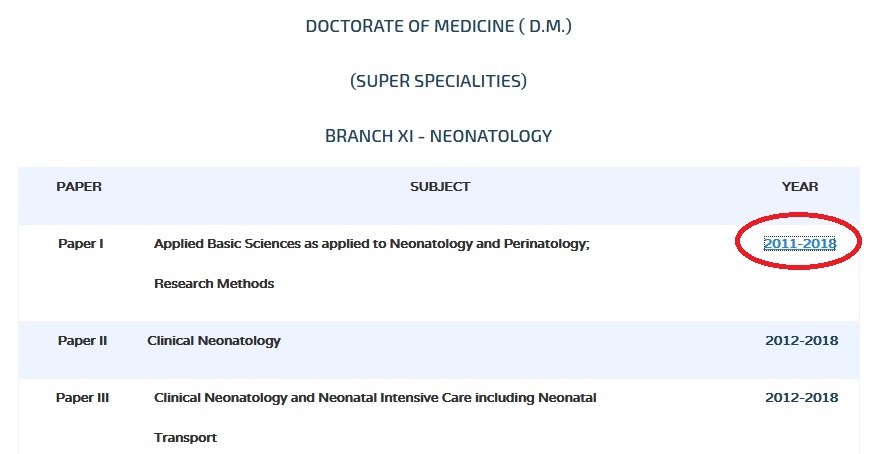Neuro Radiology, Electro Physiology, Neuro Otology, Neuro Opthalmology & Other Investigatory Procedures DM Question Bank : web.tnmgrmu.ac.in
Name of the University : The Tamilnadu Dr. M.G.R. Medical University
Degree : D.M
Branch : Branch I –Neurology
Subject Name :1453/Neuro Radiology, Electro Physiology, Neuro Otology, Neuro Opthalmology And Other Investigatory Procedures
Paper : III
Document Type : Question Bank
Website : web.tnmgrmu.ac.in
Download Model/Sample Question Paper :
2009-2014 : https://www.pdfquestion.in/uploads/web.tnmgrmu.ac.in/4393-161413KU.pdf
TNMGRMU Electro Physiology Question Paper
Sub. Code: 1453
D.M. DEGREE EXAMINATION
(Super Specialities)
(Revised Regulations)
Branch I –Neurology
(Candidates admitted from 2006-07 onwards)
Paper III– NEURO RADIOLOGY, ELECTRO PHYSIOLOGY, NEURO OTOLOGY, NEURO OPTHALMOLOGY AND OTHER INVESTIGATORY PROCEDURES
Q.P. Code: 161453
Time: Three hours
Maximum: 100 Marks
Related : TNMGRMU Clinical Neurology & Neuro Radiology M.Ch Question Bank : www.pdfquestion.in/4542.html
August 2009
ANSWER ALL QUESTIONS :
Draw suitable diagrams wherever necessary. :
I. Essays: 2 x 20 = 40 Marks
1. Discuss the merits and demerits of CT and MRI in neurological conditions.
2. Discuss the clinical and electro physiological approach to a patient with vertigo.

II. Write short notes on: 10 x 6 = 60 Marks
1. Contingent negative variation.
3. Supra nuclear control of eye movements.
4. Ophthalmo dynamometry.
5. Intra cranial pressure monitoring.
6. Tarsal tunnel syndrome.
7. Anti AcHR antibody.
8. Hyperdense MCA sign.
9. Cherry red spot.
10. Ossification of the posterior longitudinal ligament (OPLL).
February 2010
I. Essays: 2 x 20 = 40 Marks
1. Discuss on Magnetic Resonance Imaging (MRI) based approach to white matter disorders.
2. Discuss role of eletrophysiological tests in the evaluation and management of carpal tunnel syndrome.
II. Write short notes on: 10 x 6 = 60 Marks
1. Paroxysmal Vertigo.
2. Acute unilateral visual loss.
3. Transcranial doppler.
4. Laboratory diagnosis of tuberculous meningitis.
5. Sympathetic skin response.
6. Dynamic posturography.
7. Photic stimulation.
8. Laboratory diagnosis of Eaton Lambert Syndrome.
9. Electro-oculography.
10. Magneto encephalography.
August 2011
Answer ALL questions in the same order. :
I. Elaborate on :
1. Discuss the principles of MRV and discuss the role of CT,
MRI and MRV in cerebral venous thrombosis.
2. Discuss the EEG artifacts and usefulness of EEG in
Neurological disorders.
II. Write notes on :
1. Digital Subtraction Angiography.
2. Intracranial calcifications.
3. Burst suppression pattern.
4. H reflex.
5. Single fibre EMG.
6. Muscle biopsy.
7. Interventional procedures in carotid artery diseases.
8. Sleep EEG.
9. Consecutive Optic Atrophy.
10. Rinne’s test.
August 2012
Answer ALL questions in the same order. :
I. Elaborate on:
1. Discuss the presurgical evaluation and various surgical options in Intractable epilepsy.
2. Discuss the principles of Positron Emission Tomography (PET) and give an account of the role of PET in Neurological disorders.
II. Write notes on:
1. Role of Thrombolytic therapy in Acute Ischemic Stroke.
2. Vestibular Evoked Myogenic Potential (VEMP) and its usefulness in evaluation of Vertigo.
3. Principles and uses of Blink Reflex study.
4. Management of Single contrast enhancing CT lesions.
5. Somato Sensory Evoked Potential and its role in neurological diagnosis.
6. Hypsarrythmia and its clinical significance.
7. Clinical features and diagnosis of Myotonic Dystrophy.
8. Neuroimaging of Cerebral Venous sinus thrombosis.
9. TransCranial Dopper and its role in stroke.
10. Clinical features and diagnosis of Neuronal Ceroid Lipofuscinosis.
August 2013
I. Elaborate on: (2X15=30)
1. Define Computed tomogram angiography, role of Computed tomogram angiography in neurological disorders.
2. Discuss visual evoked potentials and its application in neurological disorders.
II. Write notes on: (10X7=70)
1. H Reflex.
2. Magneto encephalography.
3. Central retinal vein occlusion.
4. Otitic hydrocephalus.
5. Recurrent meningitis.
6. Rapid Eye Movement sleep behavioral disorders.
7. Supra nuclear eye movement pathways.
8. Hyper dense middle cerebral artery sign.
9. Alpha wave.
10. Periodic lateralized epileptiform discharges.
August 2014
I. Elaborate on: (2 x 15 = 30)
1. Discuss the role of magnetic resonance imaging in the diagnosis of various
leukodystrophies.
2. Discuss the clinical features and laboratory diagnosis of mitochondrial disorders
of the nervous system.
II. Write notes on: (10 x 7 = 70)
1. Sympathetic skin response.
2. Diagnosis of toxoplasmosis.
3. Skin biopsy in neurological disorders.
4. Quantitative sensory testing.
5. Brain stem auditory evoked potential.
6. Single fibre electromyography.
7. Superior orbital fissure syndrome.
8. Dynamic posturography.
9. Urodynamic study in neurological disorders.
10. Enzyme histochemistry in muscle disorders.